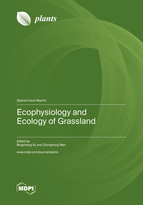Ecophysiology and Ecology of Grassland
A special issue of Plants (ISSN 2223-7747). This special issue belongs to the section "Plant Ecology".
Deadline for manuscript submissions: closed (20 January 2023) | Viewed by 26160
Special Issue Editors
Interests: native species eco-adaptation; grassland ecology; functional diversity; ecological service; grassland stability; restoration ecology
Interests: vegetation restoration and reconstruction; grassland ecological restoration; water and soil conservation; plant functional traits; GIS spatial analysis; remote sensing application analysis
Special Issues, Collections and Topics in MDPI journals
Special Issue Information
Dear Colleagues,
Natural grassland is one of the most important ecosystems on the earth, and it has multiple functions such as biomass production, ecology, economy, culture and entertainment. Natural grassland is facing various threats around the world and has become one of the most degraded ecosystems due to overuse, low maintenance input and climate change. Biomass production and species composition can comprehensively reflect grassland structure and functional changes in response to abiotic stress and environmental change. The ecophysiological and ecological analysis of key species and the community traits will be beneficial to better understand the dynamics of biomass elaboration and renewal of natural grassland. This Special Issue mainly focuses on the integrated research from species to ecosystem level in natural grasslands in response to human disturbances, abiotic stresses and climate change. We welcome the manuscripts submitted by newly minted PhDs to present their updated research results within the topic.
We are looking forward to receiving your submissions for this Special Issue.
Prof. Dr. Bingcheng Xu
Prof. Dr. Zhongming Wen
Guest Editors
Manuscript Submission Information
Manuscripts should be submitted online at www.mdpi.com by registering and logging in to this website. Once you are registered, click here to go to the submission form. Manuscripts can be submitted until the deadline. All submissions that pass pre-check are peer-reviewed. Accepted papers will be published continuously in the journal (as soon as accepted) and will be listed together on the special issue website. Research articles, review articles as well as short communications are invited. For planned papers, a title and short abstract (about 100 words) can be sent to the Editorial Office for announcement on this website.
Submitted manuscripts should not have been published previously, nor be under consideration for publication elsewhere (except conference proceedings papers). All manuscripts are thoroughly refereed through a single-blind peer-review process. A guide for authors and other relevant information for submission of manuscripts is available on the Instructions for Authors page. Plants is an international peer-reviewed open access semimonthly journal published by MDPI.
Please visit the Instructions for Authors page before submitting a manuscript. The Article Processing Charge (APC) for publication in this open access journal is 2700 CHF (Swiss Francs). Submitted papers should be well formatted and use good English. Authors may use MDPI's English editing service prior to publication or during author revisions.
Keywords
- native species
- species diversity
- functional diversity
- trait structure
- community succession
- ecological service
- ecosystem stoichiometry
- grassland stability
- climate change








